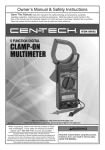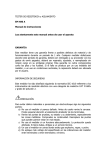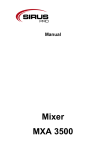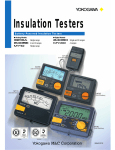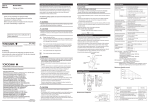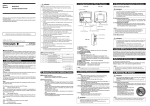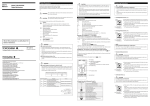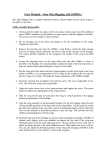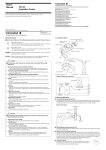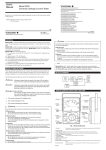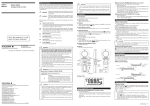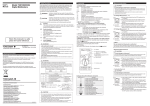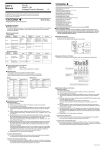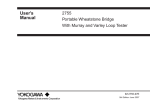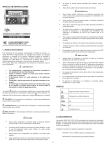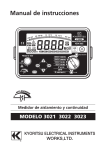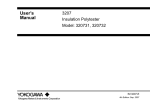Download IM 2406E-E
Transcript
User’s Manual 2406E Series Insulation Tester Yokogawa Meters & Instruments Corporation International Sales Dept. Tachihi Bld. No.2, 6-1-3, Sakaecho, Tachikawa-shi,Tokyo 190-8586 Japan Phone: 81-42-534-1413, Facsimile: 81-42-534-1426 YOKOGAWA CORPORATION OF AMERICA (U.S.A.) Phone: 1-770-253-7000 Facsimile: 1-770-251-2088 YOKOGAWA EUROPE B. V. (THE NETHERLANDS) Phone: 31-334-64-1611 Facsimile: 31-334-64-1610 YOKOGAWA ENGINEERING ASIA PTE. LTD. (SINGAPORE) Phone: 65-6241-9933 Facsimile: 65-6241-2606 YOKOGAWA AMERICA DO SUL S. A. (BRAZIL) Phone: 55-11-5681-2400 Facsimile: 55-11-5681-1274 YOKOGAWA MEASURING INSTRUMENTS KOREA CORPORATION (KOREA) Phone: 82-2-551-0660 to -0664 Facsimile: 82-2-551-0665 YOKOGAWA AUSTRALIA PTY. LTD. (AUSTRALIA) Phone: 61-2-9805-0699 Facsimile: 61-2-9888-1844 YOKOGAWA INDIA LTD. (INDIA) Phone: 91-80-4158-6000 Facsimile: 91-80-2852-1441 YOKOGAWA SHANGHAI TRADING CO., LTD. (CHINA) Phone: 86-21-6880-8107 Facsimile: 86-21-6880-4987 YOKOGAWA MIDDLE EAST E. C. (BAHRAIN) Phone: 973-358100 Facsimile: 973-336100 LTD. YOKOGAWA ELECTRIC (RUSSIAN FEDERATION) Phone: 7-095-737-7868 Facsimile: 7-095-737-7869 Thank you for purchasing the YOKOGAWA 2406E Insulation Tester. To optimize all the functions of the instrument, please read this manual thoroughly before operating it. - Model 2406 31 2406 41 2406 33 2406 43 2406 32 2406 42 2406 34 2406 44 2406 35 2406 45 6th Edition : Jun. 2006 (KP) All Rights Reserved, Copyright © 1996, Yokogawa M&C Corporation IM3E-2006.2 A3 IM 2406E-E 7th Edition July 2007 1. Regarding Safe Use of This Product 2. Components and Their Functions ■ For the safe use of this product, the following safety symbols are used on the product concerned: Danger! Handle with Care. This symbol indicates that the operator must refer to an explanation in the user’s manual in order to avoid risk of injury or death of personnel or damage to the instrument. High-voltage Terminal This symbol indicates a dangerous level of voltage (terminals fed from the interior by voltages exceeding 1000 volts must be so marked). Never touch the terminal. AC Voltage This symbol indicates that an AC voltage is present. This indicates on the product that the operator must refer to an explanation in the user’s manual in order to WARNING avoid the risk of serious injury or death of personnel. The manual describes how the operator should exercise special care to avoid electric shock or other dangers that may result in serious injury or the loss of life. This indicates on the product that the operator must refer to an explanation in the user’s manual in order to CAUTION avoid the risk of injury or damage to the product. The manual describes how the operator should exercise special care to avoid dangers that may result in injury or damage to the instrument. ■ Always observe the following instructions. Failure to observe these instructions may result in electric shock hazards or other dangers that may lead to serious injury or the loss of life. WARNING 1. During Measurement of Insulation Resistance • A high voltage is present at the probes. Do not touch the device under test (DUT) or the EARTH, LINE or GUARD terminal. 2. During Measurement of AC Voltages • Do not press the MEAS key while measuring AC voltages. • An AC voltage is present at the GUARD terminal. Do not touch the terminal. 3. Immediately After Measurement of Insulation Resistance • The probes or DUT may remain highly charged. Do not touch them immediately after the completion of measurement. 4. Probes • Use the probes supplied with this tester by Yokogawa Meters & Instruments. • Do not use probes that have deteriorated or broken. • Remove the probes from the DUT before attaching/detaching the probes to/from the tester. 5. Insulation of Casing • Punctures in the protective insulation may occur if there are any cracks or other damage in the casing as a result of the instrument having been dropped or hit against other objects. Do not use the instrument before any remedial measures are taken; ask the manufacturer for repair. 6. DUTs • Turn off electrical power to the DUT before you begin measuring insulation resistance. • Avoid touching any electrified part while using the tester around electrically live locations. For safety, it is recommended that you use a pair of rubber gloves or other alternative means. 7. Battery Replacement • Remove the probes from the DUT and then turn off the range selector switch before you open the casing to replace the batteries. • Do not touch the MEAS key during replacement. Otherwise, a high voltage may be produced. 8. Operating Environment • Do not operate the tester in an atmosphere where any flammable or explosive gas is present. • Do not use the tester if there is condensation on it. 9. Disassembly • No person, except service personnel from Yokogawa Meters & Instruments, is authorized to disassemble this instrument. ■ Always observe the following instructions. Failure to observe these instructions may result in electric shock hazards or other dangers that may lead to injury or damage to the instrument. CAUTION 1. Measurement of AC Voltages • Do not apply any voltage between terminals that exceeds the specified limit. 2. GUARD Terminal • The GUARD terminal is an auxiliary measurement terminal to eliminate a leakage current. Do not apply any testing voltage to the terminal. 3. Ranges • Do not switch between the rated voltages until two to three seconds have elapsed after the completion of each measurement. Switching between voltages immediately after the completion of measurement may result in possible damage to the tester or DUT due to the electrical charge at the probes or DUT. Note that the tester is provided with a discharge feature. 4. Power to DUTs • Electrical charges may be present at metals or wiring cables attached to electrical equipment being tested. Verify that the equipment is free from electrical charges before connecting the testing terminals. The same rule applies to the grounding wire. 5. Range Selector Switch • Do not operate the range selector switch during testing. • Do not apply any voltage to the testing terminals when measuring insulation resistance. 6. Batteries • Do not mix batteries of different types or new batteries with used ones. If the tester will not be in service for a prolonged period, always remove the batteries before you store the instrument. If you store the tester with the batteries left installed, they are more likely to suffer fluid leakage, resulting in a malfunctioning of the instrument. ■ Measurement Categories Measurement category Description Remarks 1 CAT.1 For measurements performed on circuits not directly connected to MAINS. 2 CAT.2 For measurements performed on circuits directly connected to the low voltage installation. Appliances, portable equipments, etc. 3 CAT.3 For measurements performed in the building installation. Distribution board, circuit breaker, etc. 4 CAT.4 For measurements performed at the source of the low-voltage installation. Overhead wire, cable systems, etc. ➄ Line terminal ➀ Indicator window ➅ Earth terminal ➆ Guard terminal ➂ MEAS key ➈ Bottom cover setscrew ➁ Range selector switch ➇ Bottom cover ➃ LIGHT key Indicator window Range selector switch Used to switch between the ranges for measuring insulation resistance and to select the OFF position (battery check). MEAS key Used for insulation resistance measurements and battery checks. LIGHT key Used to turn the lamp for the indicator window on or off. Line terminal Earth terminal Guard terminal Bottom cover Bottom cover setscrew Used to replace batteries. 3. Measuring the Insulation Resistance • Connecting the Probes WARNING Item 4 Securely plug the line probe into the LINE terminal and the earth probe into the EARTH terminal. • Disconnecting the Probes WARNING Item 4 1. Make sure the range selector switch is off. 2. Unplug the respective probes. • Measuring the Insulation Resistance CAUTION Items 3, 4 and 5 WARNING Items 1, 3 and 6; 1. Adjust the range selector switch to the voltage (rated voltage) to be applied to the DUT. 2. If the DUT is grounded, connect the earth probe clip to the DUT's ground line. If the DUT is not grounded, the earth probe clip may or may not be connected to the DUT's ground line. 3. Bring the line probe into contact with the DUT, and then press the MEAS key. The pointer then indicates the insulation resistance of the DUT. During measurement, exercise care to prevent the leadwire of the line probe from coming into contact with the ground, floor or other object. Not observing this precaution may result in a failure to measure the correct insulation resistance. Upon completion of measurement, always turn the range selector switch off. 4. Immediately after measurement, electrical charges resulting from the applied testing voltage may be present at the probes or DUT. The tester, therefore, is designed to automatically begin discharging electricity upon completion of measurement. • Discharge Feature Any capacitive component in the DUT will be charged during measurement and thus the DUT remains electrified even after the completion of measurement, resulting in a hazardous condition. The tester is designed to begin discharging when the MEAS key is turned off. The pointer then swings to the position on the scale proportional to the voltage that has developed across the terminals. After measurement is completed, leave the probes connected until the pointer swings back to the infinity sign (•) to allow the electricity in the DUT to fully discharge. • Locking the MEAS Key WARNING Item 1 The MEAS key, when pulled up to the right, can be locked with the key left turned on. Use this mechanism when making continuous measurement over a prolonged period. Note, however, that leaving the key turned on for an unreasonably long time will accelerate the discharge of the batteries. • Measuring Only the Volumetric Resistance WARNING Item 1; CAUTION Items 2 and 4 For example, assume that you are doing an insulation test on a cable, as shown in the figure on the right. If you bring a lead (optional) connected to the GUARD terminal into contact with an insulator overlapped by bare conducting wire, you can measure the volumetric resistance only. This is because the leakage current that flows along the surfaces of the insulator does not flow into the indicator. A dedicated lead (part number: 321803) is necessary when using the GUARD terminal. Core wire Indicating meter Power supply LINE Bare conducting wire Insulator GUARD Metal cladding EARTH Main unit Internal Wiring Entrance Cable CAT.4 Distribution Board CAT.3 CAT.2 T CAT.1 Fixed Equipment, etc. Outlet Equipment IM 2406E-E <1> 4. Measuring AC Voltages WARNING Items 2 and 6; CAUTION Items 1 and 5 The tester can also measure commercial-frequency AC voltages. When measuring insulation resistance, also use the tester to verify that there is no voltage present at the DUT. 1. Plug the probes in the same way as when measuring insulation resistance. 2. Bring the line probe into contact with the location at which the AC voltage is being measured. Read the value on the voltage measurement scale (AC V). While you are measuring AC voltages, do not press the MEAS key. 5. Other Functions Battery External dimensions Weight Safety Standard EMC Standard • Lighting Up the Indicator Window (models 240641, 42, 43, 44 and 45 only) Press the LIGHT key to turn on the scale plate lamp. Press the key once again to turn the lamp off. The lamp automatically turns off approximately 40 seconds after it has turned on. : : : : R6, AA 1.5 V (6 batteries) Approx. 120 ⫻ 110 ⫻ 60mm Approx. 500g (including batteries) Complied Standard BS EN61010-1 BS EN61010-2-31 Insulation class II Double insulation Measurement category II Polution degree 2 : Complied Standard EN55011 Group1 Class A EN61326 CAUTION This product is class A for use in an industrial environment and may cause radio interference if used for domestic use. Therefore, appropriate measures must be taken when using it for domestic use. 6. Battery Check 1. Turn the range selector switch off and then press the MEAS key. 2. The batteries are still operable if the pointer is indicating anywhere within the range for a battery check (B mark). 3. The batteries are low if the pointer fails to stay within the range. Replace the batteries by following the instructions given in Section 7 below. 7. Battery Replacement WARNING Item 7; CAUTION Item 6 1. Make sure that the range selector switch is off. 2. Loosen the bottom cover setscrew with a coin or the like, and then slide the cover off of the main unit. 3. Remove all six batteries at one time and insert new ones with their polarities set exactly as shown on the battery holder. 4. After changing the batteries, replace the bottom cover and tighten the setscrew. 8. Maintenance ■ Storage Conditions • Temperature/humidity: -10 to 60˚C/70%RH maximum • Avoid storing the tester in a location where there is: moisture, • exposure to direct sunlight, • a high-temperature heat source nearby, • exposure to severe mechanical vibrations, • a large amount of dust and/or salt, or • a corrosive gas. Note • The application of the following accessory could affect the safety and EMC performance of the product and such item should be used with this consideration. - Lead for guard terminal : 321803 • Interconnection with other apparatus is not recommended. Supplied Accessories (the items labeled to are spare parts) Description Model/PartNo. Qt'y Remarks Batteries Earth and Line probe ➀ Line probe ➁ Earth probe ➂ Hard case User’s manual R6P 6 Built-in (AA-size) ➀ ➂ 98007 B9204XD B9204XJ B9075UF (including a probe case) IM2406E-E 1 ➁ This manual ■ External Dimensions 120 53 ■ Calibration Cycle It is recommended that the tester be calibrated once every year for correct operation; ask Yokogawa Meters & Instruments to do the periodic calibration for you. 110 ■ Removal of Dirt Do not use volatile solvents (such as paint thinners or benzine) as they are likely to cause discoloration. Wipe off dirt with a cloth dampened water or alcohol. 9. Specifications ● Insulation Resistance (Standard Test Conditions: Ambient Temperature = 23 ± 5˚C; Relative Humidity = 45-75%) Model Rating Central scale First effective mark measuring range Second effective measuring range Low limit measuring resistance** Rated current AC-Voltage measuring range 240631 25 V/5MΩ 240641* 50 V/10MΩ 125 V/20MΩ 0.1MΩ 0.2MΩ 0.5MΩ 0.005-2MΩ 0.01-5MΩ 0.02-10MΩ 2MΩ (exclusive)-5MΩ 5MΩ (exclusive)-10MΩ 10MΩ (exclusive)-20MΩ 0.025MΩ 0.05MΩ 0.125MΩ 1 mA 1 mA 1 mA 0-300 V 240632 125 V/20MΩ 240642* 250 V/50MΩ 0.5MΩ 1MΩ 0.02-10MΩ 0.05-20MΩ 10MΩ (exclusive)-20MΩ 20MΩ(exclusive)-50MΩ 0.125MΩ 0.25MΩ 1 mA 1 mA 0-300 V 240633 125 V/20MΩ 240643* 250 V/50MΩ 500 V/100MΩ 0.5MΩ 1MΩ 2MΩ 0.02-10MΩ 0.05-20MΩ 0.1-50MΩ 10MΩ (exclusive)-20MΩ 20MΩ (exclusive)-50MΩ 50MΩ (exclusive)-100MΩ 0.125MΩ 0.25MΩ 0.5MΩ 1 mA 1 mA 1 mA 0-600 V 240634 250 V/50MΩ 1MΩ 240644* 500 V/100MΩ 2MΩ 1000 V/2000MΩ 50MΩ 0.05-20MΩ 0.1-50MΩ 2-1000MΩ 20MΩ (exclusive)-50MΩ 50MΩ (exclusive)-100MΩ 1000MΩ (exclusive)-2000MΩ 0.25MΩ 0.5MΩ 1MΩ 1 mA 1 mA 1 mA*** 0-600 V 240635 250 V/500MΩ 10MΩ 0.5-200MΩ 200MΩ (exclusive)-500MΩ 0.25MΩ 1 mA*** 0-600 V 240645* 500 V/1000MΩ 20MΩ 1-500MΩ 500MΩ (exclusive)-1000MΩ 0.5MΩ 1 mA*** 1000 V/2000MΩ 50MΩ 2-1000MΩ 1000MΩ (exclusive)-2000MΩ 1MΩ 1 mA*** * : denotes models with a scale plate lamp ** : denotes a value that allows the rated voltage to be maintained during testing *** : indicates that the value becomes 0.55 mA at the lower limit of the primary effective range of measurement. Standard test conditions Ambient temperature and humidity Attitude Influence of earth magnetism Battery Voltage 23 ±5˚C at 45 to 75% RH Horizontal (within 5 degrees from horizontal) Earth magnetic field Within effective range for the battery (When the battery is checked, the pointer must be within the B mark) Tolerances under the above conditions Resistance measurement : ±5% of reading within the first effective measuring range ±10% of reading within the second effective measuring range Infinity and zero indications : Up to 0.7% of scale length AC voltage : ±10% of the maximum value No load voltage : Within 130% of the rated voltage Rated measuring current : 1 mA for the first effective measuring range (-0 to +20%) Short-circuit current : 12 mA or less Scale length : Approx. 86 mm Response time : 3 sec or less untill the pointer is within tolerance from the instant the resistors whose values correspond to the midpoint and zero indications are connected abruptly. Friction : No friction is recognized. Effects of tilting : Deviation from the infinity indication when the tester is tilted or rotated by 30 degrees from the horizontal must be 2% or less of the scale length. Effect of temperature : Deviation from the midpoint indication at 20˚C must be 5% or less when ambient temperature is varied from 20˚C by ±20˚C. 0.7% or less of scale length for infinity and zero indications. Effect of humidity : Within tolerance when the tester is left for one hour with the humidity at 90% RH. Effect of external magnetic field : The change of indication must be 3% or less of the indicated value when an external field of DC 400A/m is applied in the most affected direction. Effect of AC component of voltage at measurement terminals : A change when a capacitor of 5µF ±10% is connected in parallel with a resistor corresponding to the midpoint indication connected, must be 10% or less of indication. Insulation resistance : 50MΩ or more between electric circuits and outer case, when tested at 500V if the rated measuring voltage is 500 V or less and at a voltage identical to the rated voltage if the rated voltage exceeds 500 V. Dielectric strength : 3700 V AC for one minute between the electric circuits and the outer case. Vibration proof : When a vibration frequency of 16.7 Hz and peak-to-peak amplitude of 4 mm are applied to the direction of the axis of the moving part, the specifications for tolerances, friction, and the effect of tilting must be met. Shock proof : When shock of 1000 m/s2 is applied twice in the direction of axis of the moving part and the direction perpendicuar to the axis, specifications for tolerance, friction, and effect of tilting must be met. Durability : When a resistor corresponding to the midpoint indication is connected across the measuring terminals and the power switch is repeatedly turned on and off 10,000 times at the rate of about 300 times/hour, the specifications for tolerance and friction must be met. Input mistake protection : When an AC voltage of 50 or 60Hz at 1.2 times the rated measuring voltage is applied to the measuring terminals for 10 seconds, no abnormality must occur. Operation temperature/humidity : 0 to 40˚C/90%RH or less (no condensing) Storage temperature/humidity : -10 to 60˚C/70%RH or less (No condensing; remove the battery). : : : : ■ Notice Regarding The Manual • The information contained in this manual is subject to change without notice. • Every effort has been made to ensure that the information contained herein is accurate. However, should any concerns, errors, or omissions come to your attention, or if you have any comments, please contact us. • The contents of this manual may not be transcribed or reproduced, in part or in their entirety, without prior permission. IM 2406E-E <2>


